LG Refrigerator Filter (Issues & Solutions)
Sense something wrong in the cool filtered water you’re getting from your LG refrigerator?

Or do you find any irregularity in the filter or associated components? Either way, it’s most likely that there’s a fault in the filtration system within the unit, and you’ll need to fix it at the earliest.
Filters are highly convenient sources of cool, clean water from the fridge, so most homeowners consider using them to be a healthy practice. Another point worth noting is that you may not prefer calling in a fridge repair expert to fix relatively minor issues in the filter — that will come with considerably high costs.
That’s why going the DIY way is a much better alternative in this regard. But in case you don’t have prior experience in handling refrigerator issues, you’ll have to be aware of the technicalities before starting the job.
That’s why we’ve brought you this guide on correcting all filter issues in an LG refrigerator. Read on to know more.
LG Refrigerator Filter Problems & Solutions
For a better understanding of the different issues affecting refrigerator filters, we’ve categorized them into various types. So, let’s begin.
Faults In The Air Filter And How To Fix Them
1. Resetting An Air Filter
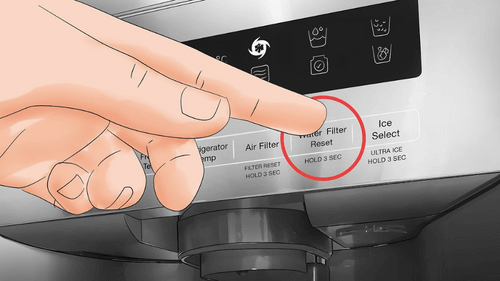
You can often correct a malfunction in the air filter of an LG refrigerator by resetting the device. Also, you should reset the filter after a replacement.
Just press and hold the air filter button on the control panel for around 3 seconds, and you’re good to go. Generally, the light of an air filter will start blinking when a change is due, and it will continue to blink till you replace and reset the filter. Even in the case of a reset without replacement, the blinking will start soon after.
But in case the light doesn’t stop blinking even after replacing the filter, ensure that you’ve installed the correct type for the refrigerator and have done it the right way. You should otherwise consider testing the fridge control board and getting a replacement for the same.
2. The Air Filter Is Stuck
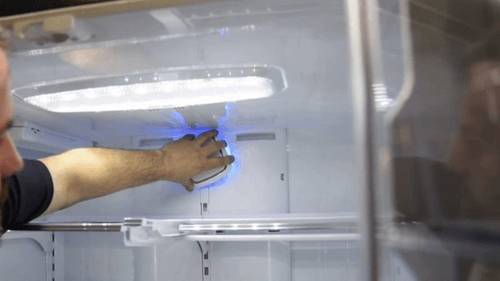
If the LG refrigerator air filter gets stuck, it might not be able to operate freely and efficiently, which is why you’ll need to loosen it.
Begin by detaching the shelf on top of the filter so that you’re able to access it easily. Following this, grab the filter using the left hand to maintain stability and hit it to the left using the right hand. The filter is sure to loosen but won’t fall as you can catch it with your left hand.
Faults In The Water Filter And How To Fix Them
1. The Change Filter Light Doesn’t Go Off
In case you can’t get the light reset despite pressing the button, try pressing and holding it again. But if that doesn’t fix the issue, press the Water Filter and Express Freeze buttons simultaneously for 3 seconds, and the Change Filter light will most likely be reset.
That said, if the problem persists, just open the refrigerator door and press the reset button while it’s still open.
Another way you can address this problem is by unplugging the fridge for about 30 seconds and plugging it back in. Also, the control board might need resetting.
2. Difficulty In Removing The Water Filter
In case the water filter becomes difficult to remove, you can try detaching the topmost shelf of the filter compartment. It might’ve become an obstruction, so you won’t be able to drop the filter down to uninstall it.
Also, fixing the filter incorrectly might make it too tight, due to which it might stop working. It will be best to reach out to a technician in such situations.
How To Fix A Dysfunctional Water Filter?
In case the LG refrigerator water filter isn’t functioning the right way, you should check for the following faults and try to correct them accordingly:
1. Wrong Filter Type Installed
Ascertain the filter type you’re using for the LG refrigerator — make sure to use only LG brand filters that are compatible with the model number of the unit. But in case you require buying the filter from any other company, you should use a reliable OEM dealer.
2. Clogging
In case the filters that you’re using are more than six months old, you’ll have to go for a replacement. Filters work to eliminate sediments or deposits, and as time passes by, some deposits may settle down within and stop the water flow. And, the filter might not be working owing to these sediments.
Install a replacement filter and observe whether the situation changes. Remember that this might be the most probable reason for the filter malfunctioning.
3. Moved Seal
In case the filter housing comes with a seal of rubber, chances are that you’ve displaced it while uninstalling the old filter. That’s why you should note this before installing the new filter. Check for the seal where you generally fix the filter and move the seal back in place.
4. Improper Installation
During the installation, ensure that you attach the water filter to the housing entirely. Then make the filter tight enough to fit properly; otherwise, you might get no or low water flow.
You might even have to detach the filter and then install it back again. If that’s required, do it immediately; and remember to consult the fridge manual for proper instructions.
5. Blockage
Another problem you should check for is whether anything is blocking the water flow holes. You should clean the holes and the filter housing before installing a replacement. In case you aren’t sure how you can do this, it’s best to call in a technician to get it fixed.
Other Filter Issues And Solutions
1. Bad Taste Of Water After A Filter Change

If you’ve recently replaced the fridge water lines, it might affect the water taste. The best way to fix this issue is to dispense a large amount of water, say 2 gallons, to clean the water lines. If you still find the taste disagreeable, turn off the power and water supply and remove the water line.
Now, connect the water yet again and check the taste. A persistent bad taste would indicate that the source water itself tastes bad, and the filter isn’t changing it. Hence, ascertain the filter type you’re using and ensure it’s an LG filter, as discussed earlier. The use of any other unreliable filter is another probable reason behind this issue.
Also, ensure that the water filter hasn’t expired — even expired LG refrigerator water filters won’t work to filter the water. This will result in the contaminants being left behind and would also expose you and your family to the risk of using an expired product.
In addition, if the source water is impure, it will taste bad. Even if the water filter is functional, it won’t improve the taste completely. That’s why you should use another purifying system afterward.
Another reason might be that the water in the fridge is stale. In case you don’t utilize it often, the water’s taste may degrade, and the filter may not be of much help in improving the taste. In this case (again), the solution is to dispense some water and then try a glass to see if the taste is better.
2. Leakage In Fridge Due To Water Filter
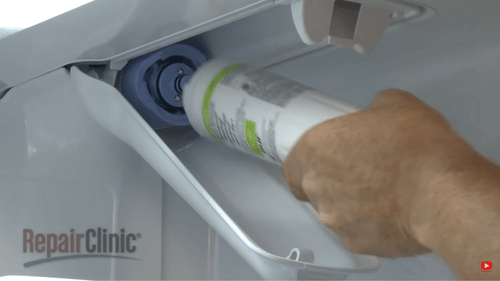
Water leakage from the fridge may arise due to a number of issues and calls for a replacement of the filter. Following are the probable causes:
- You might be using a filter that’s very old. So, if it’s been somewhat over six months since you changed it, don’t delay replacing the water filter.
- Observe the O-rings on the filter; chances are that they aren’t sealed properly or are stretched or cracked.
- Check the filter head for any damage since water may leak easily in case of such damage.
- Another part to check is the housing of the water filter, as there might be cracks on it, causing leakage.
- The power line between the refrigerator and filter might be broken, or the size of the filter might not be ideal.
3. The Water Dispenser Is Running Slow

First and foremost, ensure the valve from the water supply system in your home is entirely open. A partially opened valve may cause the water dispenser to run slow.
Checking the filter type is also important in this regard, as the wrong filter type will slow down the flow or may stop it altogether. Additionally, ensure the unit’s inlet valve is open, and dirt hasn’t choked it because if it has, you’ll have to clean the opening. But you’ll need a replacement for the valve if that doesn’t work.
Try to dispense around two gallons from the system once you’ve installed the new filter, as that would flush the air out of the system. The filter is generally air-filled while it’s new and obstructs the water flow to the dispenser.
How Do The Filters In A Refrigerator Work?
The filters in a fridge function through the chemical reaction between chlorine and activated carbon in the water. Activated carbon works like a sponge to absorb contaminants and chemicals in water and neutralizes pesticides, herbicides, and chemicals.
That said, you shouldn’t think the filters are removing every harmful substance. Most can remove only the particles that are bigger than a particular size, generally 5 microns, while the rest of the particles will get through. And, it’s mostly the bigger debris and sediment that gets trapped. The chemical reaction is considered more significant as it helps neutralize the chlorine content of the water.
Moving on, the efficiency of a filter will depend on the water temperature, the filter size, and the contact time it gets with the water. Remember that the longer the water and filter can connect, the more impurities the filter can remove.
On the whole, water filters might remove impurities like:
- Pesticides
- Asbestos
- BPA
- Pharmaceuticals
- Chlorine
- Lead
- Mercury
- Atrazine
Looking for a new LG? Check out our LG Side-by-Side Refrigerator Review, LG Instaview Door Review and our Best LG Fridge Under $3000 review
FAQs
How should you replace the water filter in an LG refrigerator?
Proceed the following way to replace the water filter in an LG refrigerator:
Step 1: Detach The Old Filter
Firstly, lift and remove the bin on the lower door of the fridge. Then swing the right side of the filter from the compartment, and grasp and rotate it counter-clockwise to detach it from the head.
Step 2: Fit The New Filter
Follow this by taking the new filter out of the packaging and removing its protective cover from the O-rings. Then insert this filter into the filter head and turn it clockwise till the arrow drawn on it lines up with that on the filter head. It’s now that you’ll have to swing the water filter back to the compartment.
Step 3: Remove Trapped Air
Next, put back the lower door bin to where it was, and dispense about 2.5 gallons of water so that the contaminants and trapped air are eliminated from the entire system. Operate the dispenser pad by depressing and releasing it for 30 seconds at the ON and 60 seconds at the OFF position instead of dispensing water continuously.
Step 4: Reset Water Filter
To complete the process, press and hold the button for the water filter for 3 seconds to turn off the indicator.
Where is the air filter located in the refrigerator?
In LG refrigerators, the air filter is centered on the rear of the refrigerator, just over its top shelf. You can access it by twisting its cover to the left so that it’s detached from the wall of the refrigerator.
How to replace the air filter in an LG refrigerator?
First of all, remove the old air filter after locating it as described above. The next steps you’ll need to follow are:
Step 1: Place the replacement air filter on the inner side of the filter cover so that the part as “Front” faces outward.
Step 2: Then place the filter back in the refrigerator by twisting the cover to the right so that it attaches to the refrigerator wall.
Step 3: After you’ve changed the air filter, push and hold the control button for 3 seconds as that will reset the sensor of the filter.
The water filter reset button of the LG refrigerator is positioned on the control panel on its door and is marked “Replace Filter.” The reset button for the air filter is on the same side as the water filter and is marked accordingly.
Will an LG refrigerator work without a water filter?
If the LG refrigerator is newer, you might be able to utilize it even without the water filter. You can determine if this is possible by uninstalling the filter and trying to dispense water. In case the dispenser continues to work, there’s a built-in bypass covering the filter. But you’ll have to use a filter otherwise.
What are the other reasons for leakage in an LG refrigerator?
Following are the probable reasons why an LG refrigerator may leak water:
1. Leaking water tank
2. Clogs in the defrost drain
3. Leakage in the water supply line
4. Cracked, improperly installed, or filled drain pan
How long will an LG refrigerator last?
An LG refrigerator water filter generally lasts for a maximum of 6 months, as we already mentioned. But in case you reside in an area where several construction activities are taking place, it’s best to replace it more often.
The lifespan of air filters is shorter — you should replace them once every three months. However, like the water filter, you should replace it more often if there are construction activities going on nearby.
Related Problems and Fixes:
Final Words
That’ll be all for today. Now, you’ll surely find it easy to tackle any of the above filter issues in your LG refrigerator, so don’t keep it unattended for long. It might be restricted to the water or air filter initially but may later give rise to a more critical fault within the unit.
Additionally, here’s another tip we’d like to share with you before signing off. Remember that different refrigerators from LG may differ in their internal structure as well as external design. Models get updated over time, and the design of the units also becomes more sleek and modern.
So, you may not find some of the components in the same part of your fridge as we’ve described. That’s why we suggest carefully studying its structure and design in the user manual before you start the troubleshooting process. This will allow you to handle the issue more effectively and understand where to look for the concerned parts in your model.
We’ll soon be back with another informative guide, so stay tuned!
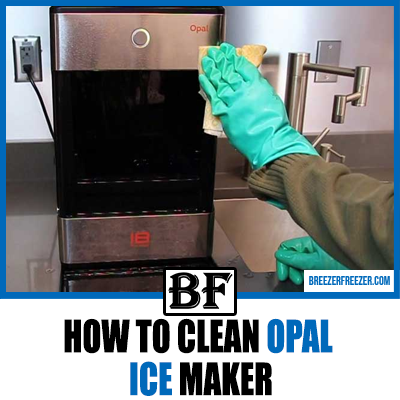

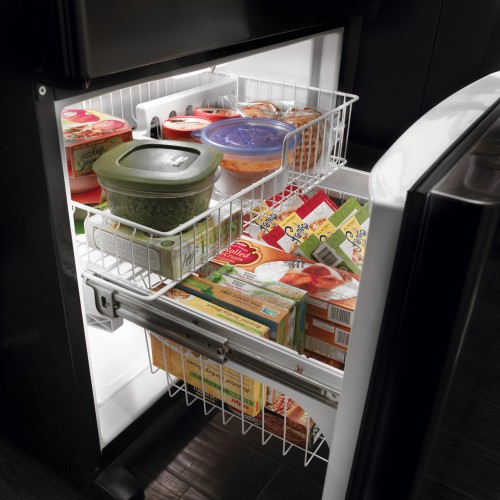

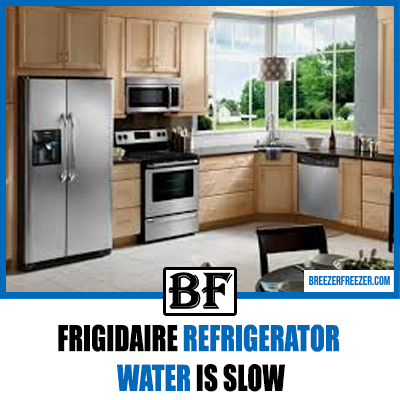
![Brand New Fridge Making Noise? [17 Causes & Fixes!]](https://breezerfreezer.com/wp-content/uploads/2023/10/Brand-New-Fridge-Making-Noise.png)